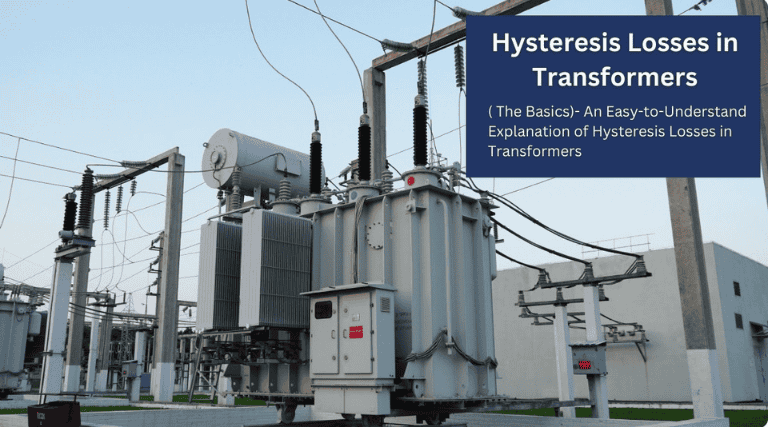- Home
- About Us
- Blog
- Services
- Equipment
- Online Testing
- Offline Testing
- Partial-Discharge
- CPC 100 Multifuncational Switchyard
- Vlf Tan Delta Measurement
- Current Signature Analysis
- Relay Measurement
- CT Measurement
- SFRA Measurement
- Moisture Analysis by PDS & PDC
- Turns-Ratio-Measurement
- Winding Resistance Measurement
- OLTC-DCRM-Measurements
- Frequency Response stray Losses
- Circuit Breaker Analyzer & DCRM Test
- Circuit Breaker Timer
- Contact Resistance Meters
- Particle Count Tester-Pamas
- TRAX Multifunctional switchyard Diagnostic Test
- TESTRANO-600
- Surge Tester-jabbals
- Circuit Breaker Analyzer
- Gallery
- Careers
- Contact Us
( The Basics)- An Easy-to-Understand Explanation of Hysteresis Losses in Transformers

A transformer is a static-electrical device that works on the magnetic or electromagnetic induction principle. The theory of the law of induction was given by Michael Friday in the year 1831. He discovered that the change( increase or decrease) in an electric magnetic field( invisible magnetic field of force) can produce current. You might not realize it, but transformers are essential for reliable power transmission and distribution, changing the magnetic flux lines(electricity voltage), managing the voltage difference in audio systems, etc.
- Transformers are used to transfer or transform the varying alternating electrical power current circuit to more than one circuit. They are used to change AS voltages in step-up ( increase) or step-down ( decrease) levels.
- Hence, we can say that transformers are important equipment in our daily life applications and are used in a variety of applications from power plants to companies, industries, and homes.
- However, one of the critical aspects of a transformer is the energy loss due to magnetization and demagnetization( magnetic saturation) state.
Therefore in this article, we will be going through hysteresis losses in Transformers, in detail. Moreover, we will delve into some more important segments and lists like causes of hysteresis losses, what is the impact of hysteresis losses on transformer efficiency, and future trends in minimizing hysteresis losses. Let us understand the concise overview of each topic one by one.
What are Hysteresis Losses inTransformers?
The word hysteresis means dynamic lag that occurs due to rotation and changes in magnetic domains. This is associated with the phenomenon when ferromagnetic materials like iron, nickel, magnetite, etc are involved.
- For every cycle of the magnetic field passing through a metallic object loses some amount of energy. This is called hysteresis.
- This lagging phenomenon or disturbance in the alignment of flux density and magnetic strength field due to magnetic agitation can reduce the life of the insulating material.
Let us move to the next paragraph to understand some critical causes of Hystersisis looses.
Causes of Hysteresis Losses?–
Hysteresis loss effects in transformers are often caused by the properties of the core material like core strength, stability, dry strength, etc. As we know Hysteresis losses in Transformers occur due to magnetization( property of attraction) and demagnetization( property of repulsion) of the transformer core.Discover the allure of luxury with our exquisite collection of replica watches, featuring the finest Rolex replicas. Our “Rolex Archives – Replica Rolex: Find the Perfect Fake Rolex Timepiece for You!” showcases stunning timepieces that capture the essence of the original. When it comes to real vs fake rolex, our replicas stand out with exceptional craftsmanship and attention to detail. Elevate your style without breaking the bank and enjoy the sophistication of a Rolex without the hefty price tag.
- When the AC changes direction, the tiny magnetic domains in the core material must realign with the new direction.
- The individual magnetic moment of the atoms isn’t perfect and results in energy being lost as heat.
- The varying rates of hysteresis loss depend on the volume of the core material( from 1.5 to 2.5), its magnetic characteristics, ambient temperature, and the frequency of the AC.
The magnetic fields depend on how their field changed in the past causing magnetization and demagnetization in the strength of the magnetizing field. The below paragraph will explain the impact of Hysteresis losses on transformer efficiency.
What is the Impact of Hysteresis Losses on Transformer Efficiency?
Energy losses are depending on the material used and quality. Every transformer undergoes hysteresis losses which reduce its efficiency. The input current oscillates forth and back manifesting minor distortion.
- Moreover, some of the input energy is lost, forming heat energy instead of being converted to useful power output. This heat needs to be managed, often with cooling systems, which increases operating costs.
- Reducing hysteresis losses is key to making transformers more efficient and reliable.
You need to pay attention to every magnetic material, ferromagnetic material, and the level of magnetization.
Please scroll down to understand the Hysteresis Loop in Tranformer.
What Do You Mean By The Hysteresis Loop?
The Hysteresis losses in Transformers eventually occur due to the repeated magnetization and demagnetization at the center of the transformer core as alternating current (AC) flows through it. Alternative current is the flow of rotational electrical charges that periodically reverses the direction. Please go through the points to understand the Hystseris loop.
- The Hysteresis loop is the four-quadrant graph that shows the behavior of the system by pointing to the relationship between the induced magnetic flux density(B) and the magnetizing strength(H) loss per magnetic cycle.
- Essentially, when the state of the system output depends on the past inputs resulting in a lag of magnetic flux density, a hysteresis curve model is formed, called a Loop.
This lag creates a loop known as the hysteresis loop. Therefore, choosing the right equipment to evaluate the B-H graph plays a significant importance.
How do Materials Effects Hysteresis Losses?-
The transformer core(center) is made up of a thin laminated stacked sheet of silicon or ferrous metal containing iron. Transformers experience two losses, one is associated with the coil, and the other with eddy currents.
- The core loss affects the materials in the transformer. Materials like silicon steel and amorphous steel have low hysteresis losses because they are easy to magnetize and demagnetize.
- This loss can also lead to a decrease the voltage regulation.
- Therefore, we can say that losses have a significant impact on the performance( operation) of the transformer.
The below paragraph will explain how to help minimize these energy losses. Please scroll down to read further.
Reducing Hysteresis Losses-
Transformers that convert or transform incoming voltage to desirable outgoing voltage are made up of different materials. There are some losses during this process and the losses or “ lagging effects” form energy dissipation resulting from the change between the magnetic flux density (B) and the magnetizing force (H) in the core material. The big question at this point is what is the material used to reduce hysteresis losses in transformers? Fortunately, as the world is progressing, there are sustainable new emerging technologies and tricks to reduce these losses.
- Selecting Better Materials: Using high-quality materials like silicon steel that have low hysteresis loss due to its higher permeability properties.
- Improving Core Design: Designing the core to have a shorter magnetic path, transformer leakage, and better flux distribution.
- Lowering Frequency: A- well-designed operating transformers at lower frequencies can reduce losses.
- Applying Heat Treatments: Treating core materials to improve their magnetic permeability properties.
Measuring Hysteresis Losses in Transformer-
The term Hysteresis was invented in the year 1890 when the current oscillates within the forward and reverse direction. To ensure the main relationship between magnetizing force flux density and transformer efficiency, measuring hysteresis losses in transformers is essential. Here, are a few methods that you can consider below.
- Calorimetric Method: It measures the amount of heat generated( change in temperature) by hysteresis losses.
- Wattmeter Method: It uses two voltage measures like same phase( line) and two currents to calculate the power loss using wattmeters. This is directly used to measure the estimated power load or supply of the system.
- Magnetizing Curve Method: This is called magnetizing B- H curve that is used through the core material’s magnetizing curve to estimate losses where B( the material flux density is measured in Telas or Mega) and the magnetizing strength force is measured in amphers.
Future Trends in Minimizing Hysteresis Losses?-
Today, transformers are getting way better benefiting both the environment and the economy. Modern electrical engineering has evolved in innovations in material science and engineering making it possible to further reduce hysteresis losses in transformers. Let’s quickly discuss some new and future trends that keep the transformer energy efficiency much higher.
- New Core Materials: The material for the core of the transformer and electromagnetics are made of ferrous metals with high permeability properties.
- Nanotechnology: The Hysteresis loss due to magnetization saturation can be reduced by using nanotechnology to enhance core materials’ magnetic properties.
- Advanced Design Techniques: The computational tools provide the detailed calculation of efficient core designs, dielectric designs, mechanical designs, and electrical characteristics.
- Smart Transformers: Implementing smart technology like smart grid deployments, advanced sensor technologies, latest communication networks to monitor and optimize performance in real time.
A note From Laxmi Associates-
Through this article, we understood that to keep our transformer running, it is important to understand hysteresis losses in Transformers and their causes.
- Laxmi Associates is the power system testing and diagnostic service industrial leader across Asia and Africa.
- Being in the industry for so long, the prestigious power system is a world-class equipment testing center that has expertise in achieving optimal performance of the power system.
- From being the top-most name in best-performing power transformers, the company offers valuable solutions to reduce the chances of Hysteresis Losses.
If you are looking for an ISO-certified electrical power distribution and transmission system company, book your schedule with the most- trusted brand in Vadodara soon.
